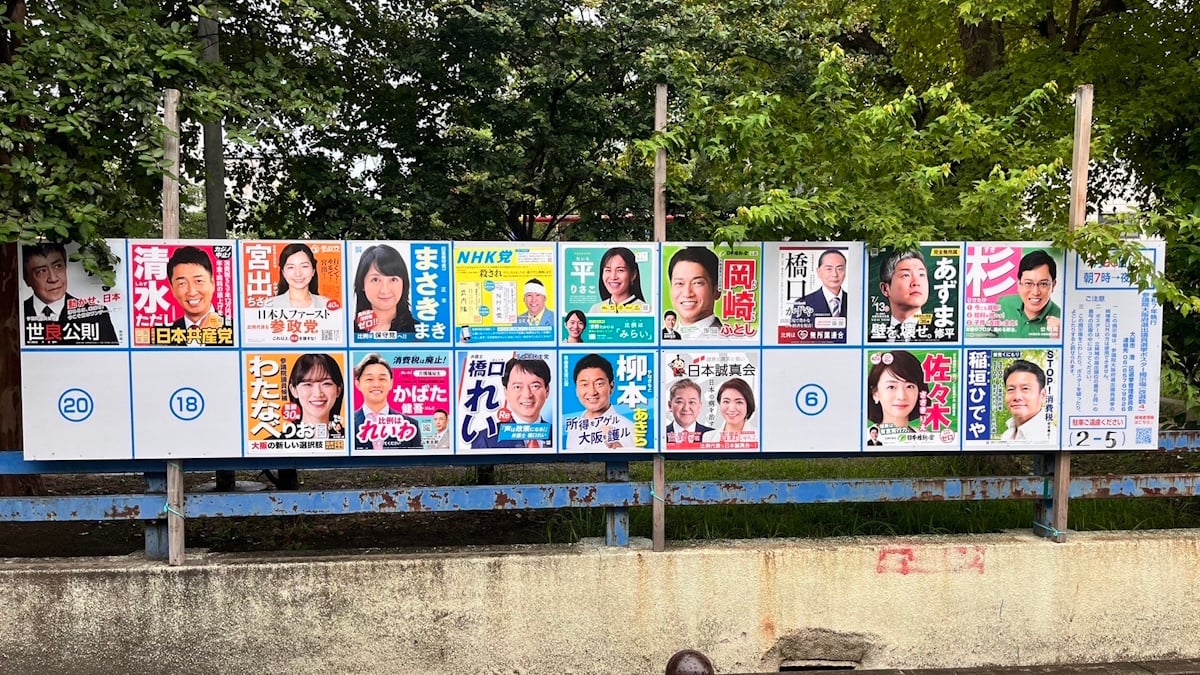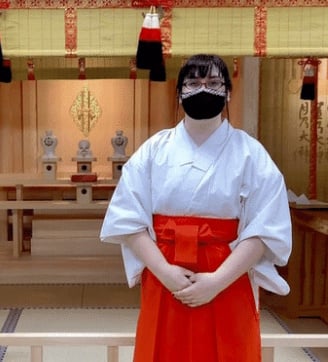With less than a week to go before the election on July 20th, Japan’s political landscape is once again in the spotlight. But for many, the maze of parties, platforms, and shifting alliances can be hard to follow.
That’s where we come in. Here are Japan’s political parties explained, from the long-dominant LDP to its rising challengers, in plain language.
The stakes are high: voters will decide who fills 124 of the 248 seats in the Upper House. The Liberal Democratic Party stands on increasingly shaky ground. Ishiba Shigeru’s 10-month tenure as prime minister hasn’t done much to restore public confidence either.
As of this article’s publication, Japan’s parties remain tangled in splits, mergers, shifting ideologies, and old grudges. The tango of betrayal, rebranding, and dissolution constantly fractures any opposition into ever-smaller factions. This allows the LDP to cling to power, not with unwavering dominance but instead a persistent, even if slippery grip.
To make sense of this political labyrinth, let’s take a closer look. Who are they? Where did they come from? Here’s a crash course on Japan’s major political parties, what they believe, and how they ended up dancing around (or directly into) the LDP.
Table of Contents
ToggleHow a group becomes a political party in Japan
Political groups in Japan can be basically divided into either parties (政党/seitō) or organizations (政治団体/seiji dantai). A group qualifies as a political party if it has five Diet members or earns 2% of the national vote in a recent election. It can be either the most recent House of Representatives (Lower House) general election or one of the last two House of Councillors (Upper House) regular elections.
This rule is why some fringe movements or celebrity-founded groups don’t qualify as political parties. They don’t have the seats or votes.
However, to understand how Japan ended up with such a fragmented political landscape, we have to rewind the clock.
Post-War Japan
After WWII ended, SCAP gutted and rebuilt Japan’s entire political system. The goal? Suppress the “militaristic nationalism” and transition Japan to a pacifist, U.S.-aligned democracy. This turned Japan from an enemy into a model Cold War ally: democratic on paper, pacifist by constitution, and strategically loyal to U.S. interests in Asia.
With the new democracy encouraging the formation of multiple parties, two conservative forces emerged: the Japan Liberal Party (日本自由党/Nihon Jiyūtō) and the Japan Democratic Party (日本民主党, Nihon Minshutō).
The JLP was the main pro-U.S. conservative bloc during the early days. The JDP was more focused on revising the new Constitution, rebuilding Japan’s military, and restoring Japanese pride. These early ideological tensions help explain the roots of Japanese political parties as we know them today, and why their modern incarnations still echo Cold War fears.
So, how did one party that prioritized pleasing the U.S. and another with a more nationalistic, pro-military stance end up merging? Because socialism was terrifying.
The Cold War’s whispers were growing louder, and Japan stood on an ideological fault line, a fragile balance of competing visions for the nation’s future. Postwar Japan saw socialism rising fast, powered by strikes, student protests, and a wave of anti-militarism that left conservatives uneasy.
The result?
The Liberal Democratic Party (自由民主党 / Jiyū Minshutō; 自民党 / Jimintō for short)

To counter the newly united Japan Socialist Party, the LDP was born of the former JLP and JDP in 1955. With the goal of consolidating conservative power, it was initially pro-business, pro-U.S. alliance, and focused on economic growth in a country devastated by war.
Conservatives didn’t proactively form the LDP. It emerged as a counterattack born of fear. If the socialists hadn’t gained such ground in 1955, conservatives wouldn’t have scrambled so hard to merge.
By the late 1960s, the socialist wave started losing steam. Between Japan’s shifting economic priorities and student radicalism disturbing public sentiments, the Japan Socialist Party’s momentum stalled. Backlash grew after mass protests, including the June 15th Incident where a student protester was killed. Tensions peaked when JSP leader Inejiro Asanuma was assassinated on live TV, rattling the nation. Behind the scenes, the U.S. quietly lent support to conservative forces, strengthening its Eastern ally in the Cold War.
With the rapid expansion of Japan’s middle class and prosperity becoming the new national dream, revolution started to not only seem unnecessary, but also inconvenient.
Today, decades of nearly uninterrupted rule, shifting public opinion, and internal divisions have reshaped the party. They are now champions of constitutional revision, defense expansion, and increasingly nationalistic rhetoric. The LDP still plays nice with the U.S., just at a more strategic, sometimes even strained social distance.
Planning a trip to Japan? Get an authentic, interpreted experience from Unseen Japan Tours and see a side of the country others miss!

"Noah [at Unseen Japan] put together an itinerary that didn’t lock us in and we could travel at our own pace. In Tokyo, he guided us personally on a walking tour. Overall, he made our Japan trip an experience not to forget." - Kate and Simon S., Australia

See a side of Tokyo that other tourists can't. Book a tour with Unseen Japan Tours - we'll tailor your trip to your interests and guide you through experiences usually closed off to non-Japanese speakers.


Want more news and views from Japan? Donate $5/month ($60 one-time donation) to the Unseen Japan Journalism Fund to join Unseen Japan Insider. You'll get our Insider newsletter with more news and deep dives, a chance to get your burning Japan questions answered, and a voice in our future editorial direction.
Yet for all of its dominance, the LDP hasn’t reigned alone.
Kōmeitō (公明党)

The relationship between religion and politics in Kōmeitō’s case has sparked ongoing controversy. Critics argue that the involvement of the Buddhist religious organization Sōka Gakkai violates Japan’s constitutional separation of religion and state. In response, Kōmeitō has publicly attempted to distance itself from its religious origins, although strong ties remain.
Ikeda Daisaku, the leader of the Japanese new religion (新宗教) Sōka Gakkai, founded Kōmeitō in 1964. They have upheld a steady manifesto centered on welfare, humanitarian support, and a dovish foreign policy.
Thanks to its ideological flexibility, Kōmeitō continues to partner with the LDP without endorsing hardline defense positions. These coalitions weren’t always part of its strategy; Kōmeitō readily joined anti-LDP coalition cabinets in 1993 and 1994. However, the party later returned to an alliance with the LDP, securing ongoing political influence without compromising its stance on pacifism. That alliance, along with a loyal base supported by Sōka Gakkai, keeps Kōmeitō from slipping into political irrelevance.
Japanese Communist Party (日本共産党 / Nihōn Kyōsantō)

The Japanese Communist Party (JCP), active since the Taisho era, remains one of the most enduring and ideologically consistent forces in Japanese politics. Founded in 1922, the party operated underground during Japan’s imperial years before resurfacing after WWII. It has consistently upheld its commitments to anti-nuclear policy, pacifism, social welfare, and opposition to the U.S. military presence.
Unlike other parties that have shifted ideologies or joined opportunistic coalitions, the JCP has consistently refused to enter coalition governments, even when doing so might have offered them clear political gains. This self-imposed isolation has proven both a strength and a weakness. The party retains a loyal voter base and moral clarity, but sacrifices broader legislative influence. The JCP peaked in the late 1970s and again in the late 1990s, though even then it held only a modest share of seats. Still, the seats it wins, it usually keeps.
When Tokyo was Socialist: the Story of Governor Minobe
Japan is often described as a one-party, conservative state – and yet, for over a decade, a highly popular socialist led the government of Tokyo. Meet Governor Minobe Ryokichi.
Although the JCP predates the Japan Socialist Party (JSP), formed in 1945, its radical stance and ties to Marxist thought led moderate reformists to create the JSP as a less polarizing leftist alternative.
Until 1996, Japanese politics followed a relatively stable rhythm. Four major players dominated the scene: the ruling Liberal Democratic Party (LDP), the opposition Japan Socialist Party (JSP), the centrist Kōmeitō backed by Sōka Gakkai, and the ever-defiant Japanese Communist Party (JCP). These core groups defined the landscape of Japanese political parties for decades. They were a choreography of opposition, coalition-building, and protest, with the LDP holding real power at the center.
That familiar political landscape began to fracture in 1996, ushering in an era of breakups, mergers, and increasing political whiplash.
Democratic Party of Japan (民主党, Minshutō)
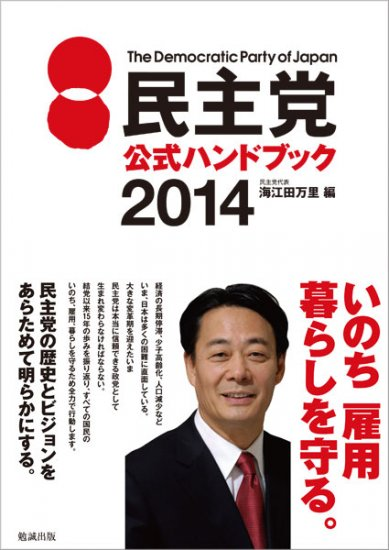
Formed in 1998, the DPJ was a pragmatic LDP alternative, promoting moderate economic reform, administrative transparency, and a balanced foreign policy. For a brief moment, their strategy succeeded. The LDP’s once-unchallenged grip began to loosen as the new century approached. Two of the party’s leading members, Hatoyama Yukio and Kan Naoto, served as Prime Minister in 2009 and 2010, respectively.
But the DPJ’s momentum quickly faded. Internal divisions, weak leadership, and a series of national crises (including the 2011 Tōhoku earthquake, tsunami, and Fukushima nuclear disaster) revealed the party’s vulnerabilities. The public criticized its response as disorganized and indecisive, eroding the trust it had earned. By 2012, voters returned to the familiar, and the LDP seized power once again under the infamous, long-reigning Abe Shinzō. The DPJ fractured soon after and officially dissolved in 2016.
The party’s downfall triggered a major political reshuffling that would ripple across Japanese political parties for years. Koike Yuriko’s short-lived Party of Hope (希望の党) offered membership by invitation only. Those who rejected her conservative vision found themselves searching for a new political home.
Which leads us to…
Constitutional Democratic Party (立憲民主党; Rikken Minshutō)

The more left-leaning members of the now-defunct Democratic Party of Japan (see below) formed what is now the second-largest political party in Japan. Beginning in October 2017 and reforming in 2020, they support raising the minimum wage, advocate for same-sex marriage, focus on gender equality, and are committed to renewable energy policies. They also strongly oppose efforts to amend the famed Article 9 of the Japanese constitution, a stance that continues to define its contrast with the ruling coalition.
With the more progressive members of the former DPJ rallying behind the CDP, the party’s remaining centrists and conservatives also needed a new political home.
Democratic Party for the People (国民民主党; Kokumin Minshutō)

The DPFP emerged from the failures of the Party of Hope, which many initially viewed as a viable centrist-to-right alternative to the LDP. Despite early enthusiasm, the Party of Hope performed poorly in the election and quickly stalled due to internal ideological divisions.
By 2018, the remnants of the Democratic Party and the Party of Hope merged to create the DPFP. The new party sought broad centrist appeal, promoting economic pragmatism, selective cooperation with the LDP, and a more muted ideological tone.
Today, the DPFP identifies as centrist-conservative. It advocates for greater transparency in social insurance programs, regulation of land resale, and supportive wage policies. The party favors fiscal responsibility without fully endorsing austerity and takes a cautious stance on defense, distinguishing itself from both the LDP and more progressive rivals.
Before the current election, the DPFP was the country’s rising conservative stars. They were ranked more popular among young voters than the LDP. However, a series of recent stumbles – including an admitted affair by DPFP head Tamaki Yūichirō – have seen the party lose support rapidly.
Planning a trip to Japan? Get an authentic, interpreted experience from Unseen Japan Tours and see a side of the country others miss!

"Noah [at Unseen Japan] put together an itinerary that didn’t lock us in and we could travel at our own pace. In Tokyo, he guided us personally on a walking tour. Overall, he made our Japan trip an experience not to forget." - Kate and Simon S., Australia

See a side of Tokyo that other tourists can't. Book a tour with Unseen Japan Tours - we'll tailor your trip to your interests and guide you through experiences usually closed off to non-Japanese speakers.


Want more news and views from Japan? Donate $5/month ($60 one-time donation) to the Unseen Japan Journalism Fund to join Unseen Japan Insider. You'll get our Insider newsletter with more news and deep dives, a chance to get your burning Japan questions answered, and a voice in our future editorial direction.
Reiwa Shinsengumi (れいわ新選組)

If you’ve ever seen Battle Royale, you’ve probably encountered Yamamoto Tarō; actor turned activist and leader of Reiwa Shinsengumi. He founded the party in 2019, making it the loudest and most theatrical left-wing force in modern Japanese politics. Positioned further left than the CDP, Reiwa champions wealth redistribution, disability rights, and anti-nuclear energy. Its platform includes abolishing the consumption tax, radically expanding social welfare, and raising wages through direct government action.
Reiwa also stands out for running candidates with severe disabilities. It emphasizes inclusion not only in policy but in representation itself; a rare stance among Japanese political parties.
Those familiar with Japanese history may raise an eyebrow at the party’s name. The original Shinsengumi, loyal to the Tokugawa shogunate, served as a reactionary secret police; not exactly a progressive model. Whether Yamamoto chose the name for its iconic value, to reclaim it, or simply because it sounds bold, it certainly reflects his flair for drama.
Despite its size, Reiwa Shinsengumi has built a loyal following, particularly among younger, disillusioned voters who still make it to the polls. In an age of low turnout among Japan’s youth, that alone is impressive.
But they’re not the only newer party stirring things up lately.
Sanseitō (参政党)

If Reiwa Shinsengumi is the theatrical left, Sanseitō serves as its conspiratorial mirror on the far right. Nationalist, anti-vaccine, and hawkish on defense, the party frequently spreads misinformation, especially claims that foreigners receive preferential treatment in Japan. It calls for reducing the number of foreign workers, banning overseas land ownership, and opposes same-sex marriage and the LGBT Understanding Promotion Act. Sanseitō also advocates for rewriting the constitution and removing foreign military bases from Japanese soil.
The party was formed in 2020. Its leaders quickly claimed that the COVID-19 pandemic was staged. They often promote conspiracy theories as part of their broader messaging.
Unlike traditional far-right parties driven by nostalgia or frustration, Sanseitō attracts a surprising base. Many are apolitical, affluent individuals drawn to wellness, spirituality, and organic lifestyles. These seemingly benign interests often serve as a gateway to the party’s deeper positions; constitutional revision, vaccine skepticism, and nationalist education reform. Its rapid growth highlights how Japanese political parties are increasingly tapping into lifestyle-based identities and distrust in mainstream institutions.
Like Reiwa Shinsengumi, Sanseitō commands a dedicated following among younger voters who feel ignored in a system skewed toward the elderly. This shift hasn’t gone unnoticed. LDP politicians increasingly worry about losing youth support.
While Sanseitō is conservative, most of its supporters reject Kishida’s leadership and want a movement where they feel seen. Indeed, most of Sanseitō’s supporters on platforms such as X spend as much time attacking members of the LDP as they do members of the more liberal parties.
NHK Party (NHKから国民を守る党)
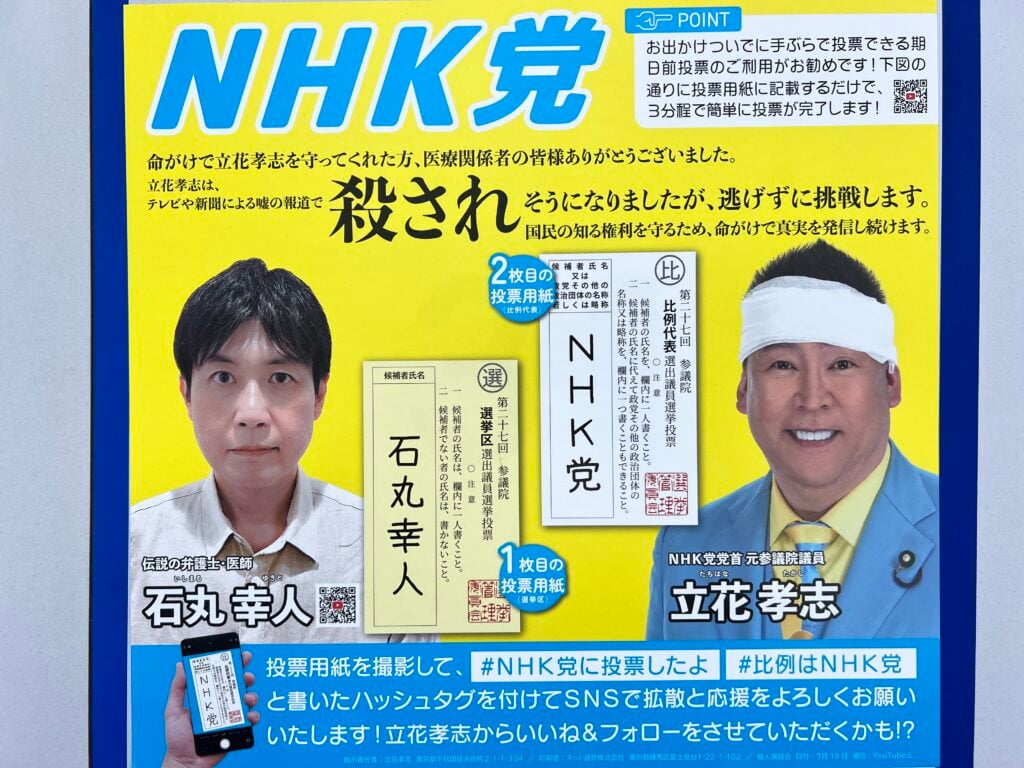
Founded in 2013, the NHK Party gained brief notoriety for its rather eccentric platform: protecting citizens from paying NHK license fees. (We covered their rise several years ago.) Their anti-establishment antics, conspiracy-tinged messaging, and viral campaigns attracted enough attention to win seats in the Diet for a time. Their stunts – such as appearing (ironically) on NHK dressed in silly costumes – have inspired other self-promoting figures like Chiba’s “Joker,” Kawai Yūsuke.
The party is led by a former NHK worker, Tachibana Takashi. Unfortunately (for the party, not Japanese society), the party has floundered due to Tachibana’s rampant egotism and its general nuttiness.
At one point, Tachibana put Ōtsu Ayaka in charge of the party and renamed it the Female Politicians 48 Party (政治家女子48党; seijika joshi 48 tou). After a financial dispute, Ōtsu locked him out of the party’s accounts, effectively shutting him out. (The new NHK Party is a reconstituted version of Tachibana’s old party, which Ōtsu now runs as The Collaborative Party.)
Around the same time, one of the party’s elected members, the YouTuber GaaSsy, lost his seat in the Diet. The reason? He was taking refuge in Dubai due to an arrest warrant over threats and slander back home. GaaSsy never showed up for a single day of work.
As of 2025, the NHK Party no longer holds any seats. If they continue to lose momentum, they risk losing official status under the criteria that define Japanese political parties.
Japan Innovation Party (日本維新の会)

“A revolution that cuts through vested interests – the Innovation Party can deliver”
Founded in 2015 as Initiatives from Osaka, the Japan Innovation Party positions itself as a reformist alternative to the LDP. It emphasizes efficiency, decentralization, and fiscal conservatism. Though sometimes labeled as right-wing, their stances are more populist and pragmatic than ideological, earning them a more center-right position.
The Innovation Party has gained ground in urban areas, particularly within Kansai, and is now the third-largest party in the Diet behind the LDP and the CDP. However, it hasn’t yet managed to overcome its image as a primarily regional party.
Conservative Party of Japan (日本保守党)

Launched in 2023, the Conservative Party of Japan (CPJ) quickly gained traction through social media and sharp nationalist messaging. Fiercely anti-immigration, anti-China, and pro-constitutional revision, the party mirrors other far-right movements while appealing to voters who believe the LDP has grown too moderate. While younger voters drift toward Sanseitō, more traditional nationalists who once hoped the LDP would move further right now look to the CPJ instead.
Japan 2025 – and beyond
Japan’s political landscape in 2025 feels more fractured and reactive than ever. Legacy powerhouses cling to control, while fringe movements rise on waves of disillusionment and digital charisma. Whether this shift signals a slow reinvention of Japanese democracy or a deeper entrenchment of the status quo remains uncertain. As coalitions crumble and new parties claw their way onto the stage, the real question isn’t just who will win. It’s what kind of Japan they want to build.
As the election draws near, one thing is certain: the era of quiet predictability in Japanese political parties is long gone.
Why this page doesn't look like crap
You may notice a few things about this page. First, it’s mostly content – not ads. Second, this article was written by a human, not a plagiaristic Turing machine.
Unseen Japan is a collective of independent authors. We work hard to keep our content free of intrusive ads and AI slop.
Help us keep it that way. Donate to the Unseen Japan Journalism Fund to support our work. Regular donors will receive Insider, our paid newsletter with weekly bonus content about Japan. Plus, your contribution will help us produce more content like this.
What to read next
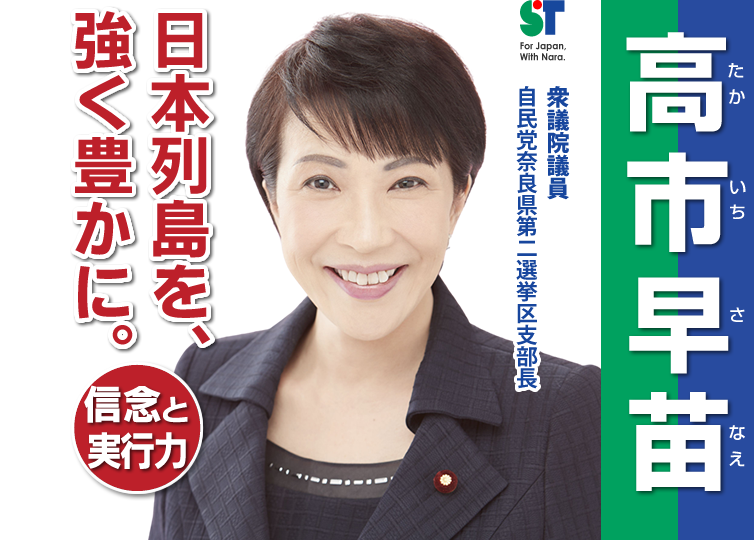
“Honorary Man”: Takaichi Sanae Scorned, Shunned by Japanese Feminists
The woman who may be Japan’s first prime minister is under fire for her “fossil-like thinking” on women’s rights.

Saitama Lawmaker States Foreigners in Japan Have “No Fundamental Human Rights”
The lawmaker later backtracked on the statement, saying that he only meant they didn’t have “the same rights” as Japanese citizens.

Japanese Politician Says Tourists Are Kicking Nara’s Deer. But Where’s Her Evidence?
Are foreigners mistreating the deer in Nara? One prominent Japanese politician says so – but the facts don’t back her up.
